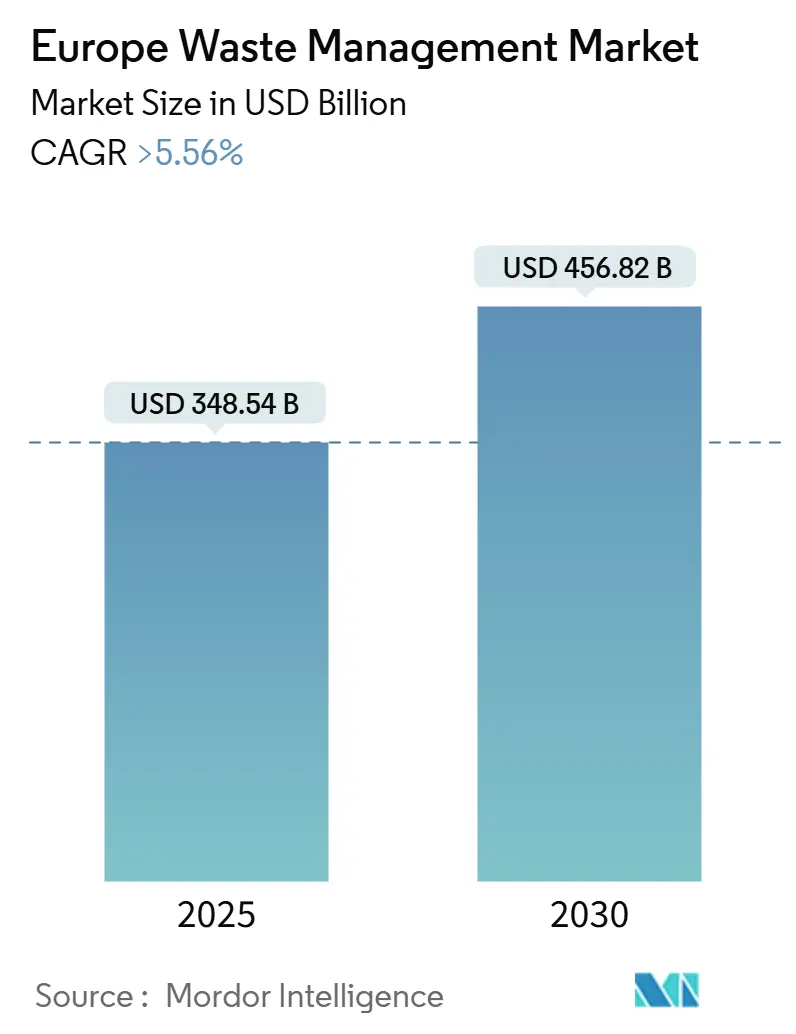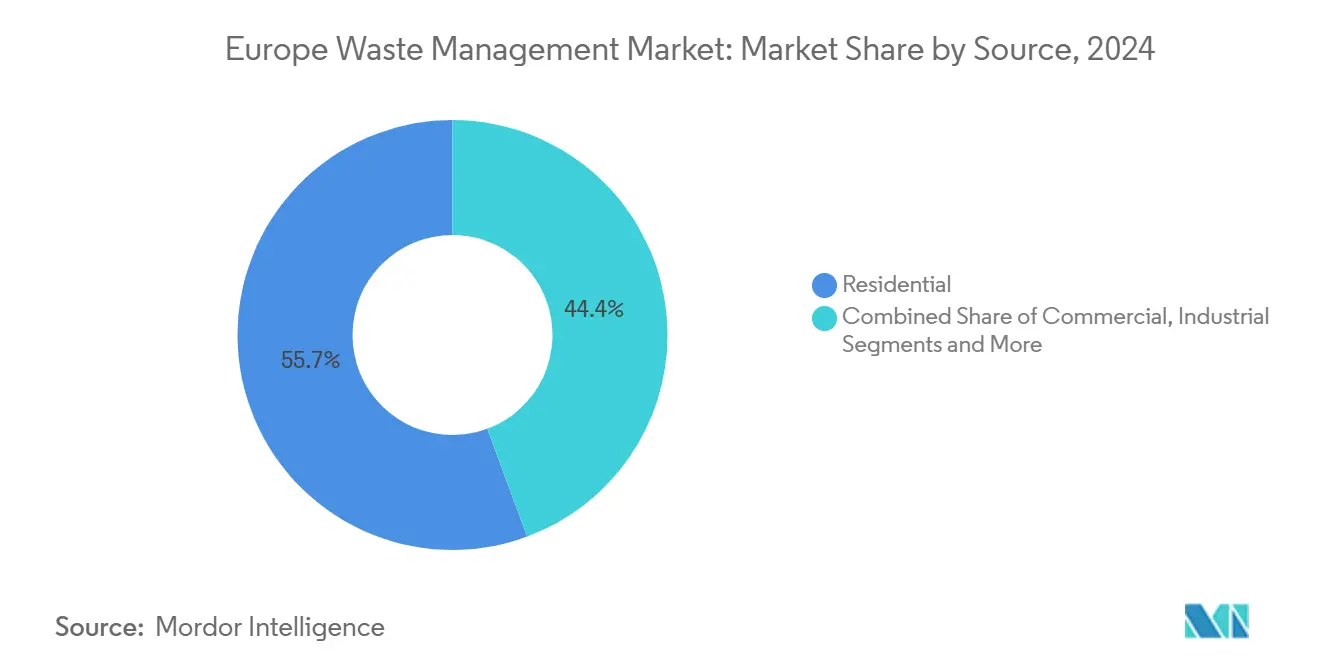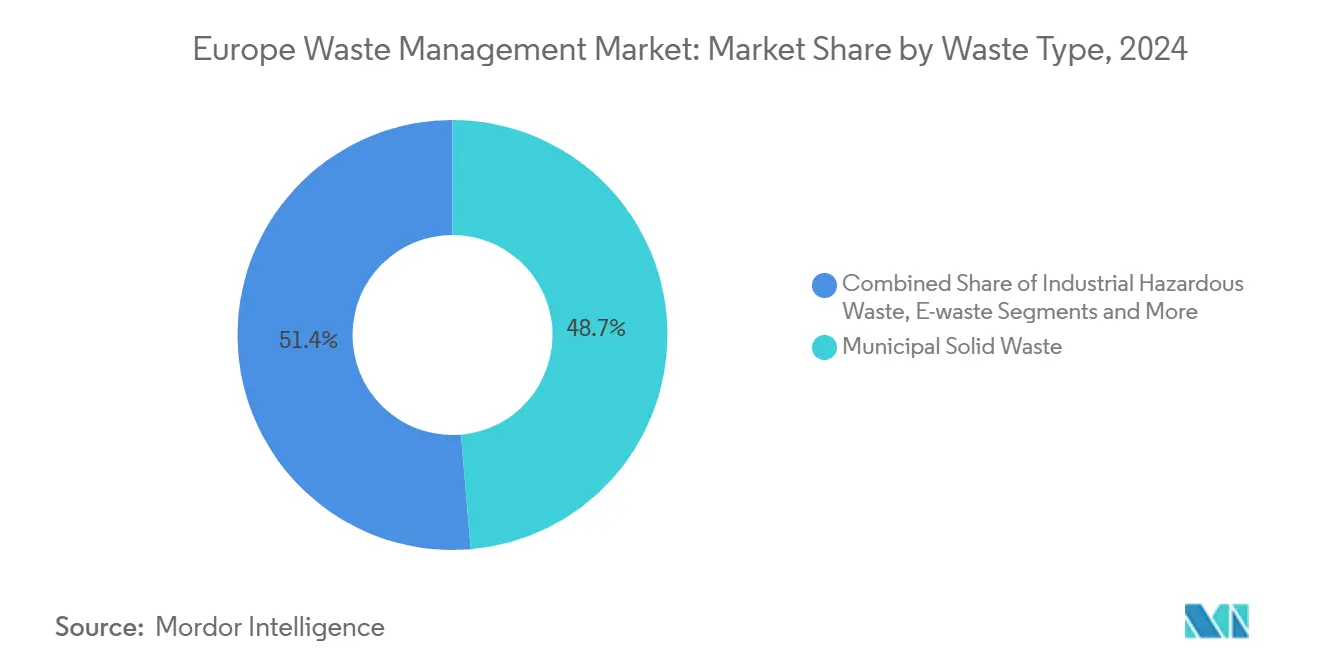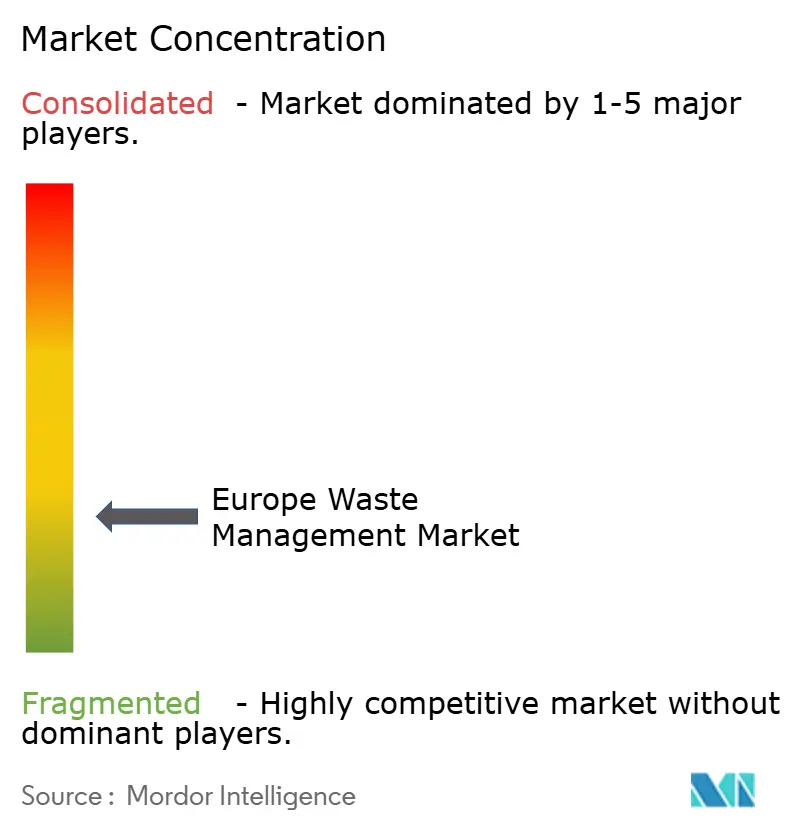Europe Waste Management Market Size and Share

Europe Waste Management Market Analysis by Mordor Intelligence
The European Waste Management Market size is estimated at USD 348.54 billion in 2025 and is projected to reach USD 456.82 billion by 2030, advancing at a 5.56% CAGR over the forecast period. This solid growth path underscores how the European waste management market is benefiting from strict landfill‐reduction mandates, fast-rising investment in waste-to-energy (WtE) assets, and an unmistakable shift toward circular economy principles. Regulatory pressure, most notably the European Union’s requirement to cap municipal landfilling at 10% by 2035, is accelerating capital inflows into recycling, chemical recovery, and AI-enabled collection systems, while creating a step-change in demand for advanced treatment technologies. Germany remains the anchor market, leveraging mature Extended Producer Responsibility (EPR) systems and robust WtE networks, yet Spain is now the headline growth story as large-scale chemical recycling plants and smart-bin pilots unlock new capacity. Across the value chain, leading operators are acquiring complementary assets to build fully integrated service offerings, and data-centric start-ups are monetizing analytics that cut truck mileage, carbon emissions, and operating costs[1]European Commission, “Circular Economy Action Plan,” ec.europa.eu.
Key Report Takeaways
- By source, residential waste accounted for 55.65% of the European waste management market share in 2024, whereas commercial waste is forecast to expand at a 7.31% CAGR through 2030.
- By service, disposal and treatment captured 47.3% of the European waste management market size in 2024, while recycling and resource recovery lead growth with a 7.41% CAGR over the same horizon.
- By waste type, municipal solid waste held a 48.65% share of the European waste management market size in 2024; e-waste is advancing fastest at a 6.20% CAGR to 2030.
- By geography, Germany dominated with 22.32% of the European waste management market share in 2024, whereas Spain is poised to register the highest 5.90% CAGR through 2030.
Europe Waste Management Market Trends and Insights
Drivers Impact Analysis
| Driver | (~) % Impact on CAGR Forecast | Geographic Relevance | Impact Timeline |
|---|---|---|---|
| EU landfill-to-10% mandate (2035) | +1.2% | EU-27; strongest in Germany, France, Italy | Medium term (2-4 years) |
| Rapid growth of e-commerce packaging waste | +0.9% | Western Europe; spillover to Eastern Europe | Short term (≤ 2 years) |
| Extended Producer Responsibility scaling | +0.8% | EU-27; early BENELUX & Nordics adoption | Short term (≤ 2 years) |
| AI/IoT smart-bin deployments | +0.7% | Urban centers: Barcelona, Amsterdam, Berlin | Medium term (2-4 years) |
| Chemical-recycling projects | +0.6% | Germany, Austria, Netherlands; expanding EU-27 | Long term (≥ 4 years) |
| Cement co-processing demand for RDF | +0.4% | Industrial belts: Germany, Italy, Eastern EU | Medium term (2-4 years) |
| Source: Mordor Intelligence | |||
EU Landfill-to-10% Mandate Drives Infrastructure Transformation
The 10% cap on landfilling is rewriting municipal budgets and planning calendars across the European waste management market. Germany already operates near-zero landfill levels, yet Spain and Italy are quickly adding WtE lines and high-throughput MRFs to stay on track for 2035 compliance. Penalties for non-compliance, coupled with restricted EU funding, are pushing even slower adopters to redirect residual waste toward energy recovery or advanced recycling. Operators such as SUEZ have responded with district-heating WtE projects that convert waste into 360 GWh of heat annually for Toulouse, demonstrating how compliance can unlock new utility revenue. As the lowest-cost disposal option disappears, every stakeholder now optimizes around higher-value treatment pathways that strengthen the circular economy.
E-commerce Packaging Waste Surge Creates Specialized Processing Demand
A spike in online shopping yields complex, multi-layer packages that frustrate conventional recycling. New UK rules starting March 2025 obligate firms to separate food waste and dry recyclables, forcing reverse-logistics partnerships and dedicated processing lines. Chemical recycling plants, such as LyondellBasell’s USD 44 million Wesseling unit, target composite films that traditional systems reject. Operators who master this niche command premium gate fees, giving the European waste management market fresh revenue streams.
Extended Producer Responsibility Scaling Accelerates Packaging Circularity
Full EPR rollout across the EU by 2025 embeds end-of-life costs directly in product pricing, incentivizing lighter, mono-material packaging and financing county-wide collection upgrades. France already requires environmental disclosure on labels, while Spain mandates on-pack sorting instructions, creating multi-country compliance complexity that favors pan-European operators. Differential eco-fee structures tied to recyclability are driving producers to collaborate with waste firms on design-for-recycling programs. Textile EPR, slated for 2026-2027, will inject millions of tons of garments into separate collection streams, widening the service addressable market of the European waste management market.
AI and IoT Smart-Bin Deployments Optimize Collection Efficiency
City pilots in Barcelona, Amsterdam, and Copenhagen showcase fill-level sensors, predictive algorithms, and blockchain reporting that cut overfilled bins by 20% and route mileage by 25%. These gains lower OPEX for haulers, reduce CO₂ emissions, and allow municipalities to introduce performance-based service contracts. Portable robotic MRFs under the RECLAIM project further extend advanced sorting to rural regions lacking large fixed infrastructure, widening coverage across the European waste management market[2]AI4Europe, “RECLAIM Project Overview,” ai4europe.eu.
Restraints Impact Analysis
| Restraint | (~) % Impact on CAGR Forecast | Geographic Relevance | Impact Timeline |
|---|---|---|---|
| WtE incinerator CAPEX & social license | -0.9% | Western Europe: Germany, the Netherlands, the UK | Long term (≥ 4 years) |
| Plastic recycling capacity stagnation | -0.6% | EU-27; sharper in Southern & Eastern regions | Medium term (2-4 years) |
| Talent shortage for AI-driven operations | -0.4% | Urban tech hubs across Europe | Short term (≤ 2 years) |
| Municipal “zero-incineration” activism | -0.3% | Germany, the Netherlands, Belgium, and parts of France | Medium term (2-4 years) |
| Source: Mordor Intelligence | |||
Waste-to-Energy Infrastructure Faces Capital and Social Acceptance Barriers
Typical WtE units cost USD 220–440 million, and permitting can stretch seven years, exposing sponsors to policy shifts and rising interest rates. Community push-back, especially in densely populated corridors, slows approvals despite proven emission controls. Activist pressure for “zero-incineration” policies has forced developers to invest in real-time emissions dashboards and carbon-capture add-ons, elevating project economics and capping capacity additions.
Plastic Recycling Capacity Stagnation Limits Circular Economy Progress
Closures such as Biffa’s Washington plant highlight razor-thin margins when virgin polymer prices fall. Contamination, composite films, and uncertain commodity markets deter fresh CAPEX. As a result, some waste streams continue to leave Europe, eroding the credibility of domestic circularity pledges and restraining the European waste management market.
Segment Analysis
By Source: Household Waste Still Dominates While Commercial Waste Gains Momentum
Residential sources held a commanding 55.65% share of the European waste management market in 2024, underscoring how predictable household generation patterns underpin collection routes, fee structures, and municipal budgets. Smart-bin rollouts in Berlin and Copenhagen are optimizing collection frequency and cutting truck miles, keeping cost escalation in check. Although households remain the volume anchor, commercial sources are emerging as the primary growth lever with a forecast 7.31% CAGR through 2030. The surge is rooted in e-commerce packaging and the mushrooming of flexible workspaces that generate light but bulky streams requiring specialized baling and reverse logistics.
Commercial waste expansion injects new materials corrugated board, multi-layer films, and discarded IT equipment, into the European waste management market, demanding tailored segregation and advanced treatment. Logistics hubs near Madrid and Milan are piloting robotics that pre-sort cardboard and plastic, while office towers in Paris are embedding fill-level sensors to trigger just-in-time pickups. Industrial waste remains a steady contributor, yet its growth is tempered by process efficiency gains and near-sourcing, whereas healthcare waste scales in line with aging populations, supporting niche operators in thermal disinfection and autoclave services.

Note: Segment shares of all individual segments available upon report purchase
By Service Type: Treatment Leads but Resource Recovery Is Racing Ahead
Disposal and treatment services accounted for 47.3% of the European waste management market share in 2024, reflecting decades of investment in WtE plants and compliant landfills. High-temperature incineration equipped with energy recovery delivers baseload heat to district networks in Lyon and Warsaw, while mechanical-biological treatment facilities in Bavaria maximize metal and plastic extraction before sending rejects to cement kilns. Recycling and resource recovery, however, is forecast to grow at a 7.41% CAGR, making it the headline expansion narrative.
Material value recognition, EPR fee pass-throughs, and brand sustainability goals are steering residual flows into closed-loop processes. The European waste management market size for resource recovery is benefiting from chemical recycling breakthroughs such as OMV’s ReOil plant, which processes 16,000 tons of hard-to-recycle plastics annually. Consulting, audit, and training services are blossoming as corporates seek ISO 14001 compliance and life-cycle assessments. AI-enabled fleet telematics minimizes unproductive miles, and predictive maintenance keeps balers and shredders running at peak availability, lifting margins across the service stack.
By Waste Type: Municipal Solid Waste Retains Scale as E-waste Outpaces All Others
Municipal solid waste secured 48.65% of the European waste management market size in 2024, confirming its status as the bedrock of the sector. Household residuals, organic fractions, and neighborhood recyclables fill most collection trucks each morning. Yet device turnover and digitalization are pushing e-waste ahead at a 6.20% CAGR, making it the fastest-growing fraction.
E-waste carries valuable rare earths but also hazardous substances, requiring certified dismantling lines and compliant downstream metal smelters. Operators across Germany and Austria now deploy optical sorters and robotic pickers that isolate printed circuit boards at high speed, boosting recovery yields. Industrial hazardous waste commands premium gate fees but faces volatile volumes tied to output cycles. Construction rubble increasingly heads for recycling as secondary aggregates for road bases, while agricultural biomass feeds anaerobic digesters such as the USD 9.46 million Genia Bioenergy plant in Romania that converts 60,000 tons of manure into grid-quality gas.

Note: Segment shares of all individual segments available upon report purchase
Geography Analysis
Germany held 22.32% of the European waste management market share in 2024, underpinned by stringent EPR statutes, near-zero landfill reliance, and a dense WtE asset base that reliably converts residual waste into district heat and power. Operators enjoy stable feedstock contracts and public trust, yet emerging “zero-incineration” campaigns in cities like Hamburg require adaptive outreach and investments in carbon-capture retrofits. Spain, by contrast, offers the European waste management market its fastest CAGR at 5.90% through 2030 as Valencia and Andalusia channel EU funds into chemical recycling clusters and AI-driven route-optimization pilots.
France remains pivotal; Veolia’s USD 264 million WtE facility in Aube exemplifies the nation’s strategy to blend thermal treatment with material recovery, while producer-obligation schemes finance nationwide glass, paper, and plastic take-back. In the United Kingdom, the March 2025 Simpler Recycling law forces a single, harmonized set of materials to be collected from businesses, unlocking scale efficiencies and predictable feedstock that raise the European waste management market size for segregation services. BENELUX countries showcase near-universal separate collection, with the Netherlands recycling 99% of construction debris, serving as a blueprint for circular buildings.
Nordic nations excel in integrating WtE heat with municipal grids, keeping landfill rates among the world’s lowest and proving that high living standards dovetail with high recovery rates. Eastern and Southern Europe Romania, Bulgaria, Greece are catching up as EU cohesion funds subsidize greenfield MRFs, digesters, and sealed landfills. These markets present double-digit organic growth potential for mid-tier firms willing to navigate complex permitting and currency risk, expanding the addressable frontier of the European waste management market[3]Local Government Association, “Simpler Recycling Implementation Guide,” local.gov.uk.
Competitive Landscape
The European waste management market features moderate fragmentation: global majors such as Veolia and SUEZ combine comprehensive coverage with strong balance sheets, while agile regional specialists use deep local knowledge to defend municipal contracts. M&A remains brisk; Energy Capital Partners closed a USD 2.63 billion take-private of Biffa to expand UK recycling capacity, and Macquarie’s takeover of Renewi gives the investor a 10 million-ton processing footprint across BENELUX.
Vertical integration is the central playbook. Operators are acquiring chemical recyclers, RDF pelletizers, and digestate processors to secure feedstock and margin across the chain. Horizontal roll-ups target fragmented collection territories to raise route density, leverage fleet telematics, and reduce average cost per ton. Technology now sets the competitive cadence: firms embedding AI route-planning report 10-15% EBITDA uplift, while blockchain-based traceability platforms win high-margin compliance contracts with electronics and pharmaceuticals producers.
Stable, inflation-linked cash flows and EU policy tailwinds buoy private-equity interest. Yet social-license risks around new incinerators and plastics pyrolysis plants inject due diligence complexity. Companies able to demonstrate best-in-class emissions control, transparent stakeholder engagement, and credible net-zero pathways will capture the lion’s share of growth in the European waste management market.
Europe Waste Management Industry Leaders
-
Veolia
-
Suez
-
Remondis
-
FCC Environment
-
PreZero
- *Disclaimer: Major Players sorted in no particular order

Recent Industry Developments
- June 2025: Macquarie Asset Management and British Columbia Investment Management Corporation finalized the acquisition of Renewi, processing 10 million t/year across Europe to accelerate circular economy services.
- June 2025: EQT entered exclusive talks to acquire Waga Energy, operator of 50 landfill gas upgrading units with a 16.8 TWh pipeline.
- February 2025: Energy Capital Partners completed a USD 2.63 billion acquisition of Biffa, targeting UK carbon-reduction initiatives.
- December 2024: SUEZ and Banque des Territoires won a 20-year concession for two Toulouse WtE plants delivering 220 GWh power and 360 GWh heat.
Europe Waste Management Market Report Scope
The Waste Management (or waste disposal) market includes the activities and actions required to manage waste from its inception to its final disposal. This includes the collection, transport, treatment, and disposal of waste, together with monitoring and regulation of the waste management process.
Europe Waste Management Market is segmented By Waste Type (Industrial Waste, Municipal Solid Waste, Hazardous Waste, E-waste, Plastic Waste, Bio-Medical Waste and Other Waste Types), By Disposal Methods (Landfill, Incineration, Dismantling, Recycling), By Type of Ownership (Public, Private, Public-private Partnership), By Country (United Kingdom, Germany, France, Italy, Russia, Switzerland, Netherlands, Poland, Luxembourg, Belgium, Denmark, Sweden, Norway, Rest of Europe).
A comprehensive background analysis of the Europe Waste Management Market covering the current market trends, restraints, technological updates, and detailed information on various segments and the competitive landscape of the industry. The impact of COVID-19 has also been incorporated and considered during the study.
| Residential |
| Commercial (retail, office, etc.) |
| Industrial |
| Medical (Health and Pharmaceutical) |
| Construction & Demolition |
| Others (institutional, agricultural, etc) |
| Collection, Transportation, Sorting & Segregation | |
| Disposal / Treatment | Landfill |
| Recycling & Resource Recovery | |
| Incineration & Waste-to-Energy | |
| Others (Chemical Treatment, Composting, etc.) | |
| Others (Consulting, Audit & Training, etc.) |
| Municipal Solid Waste |
| Industrial Hazardous Waste |
| E-waste |
| Plastic Waste |
| Biomedical Waste |
| Construction & Demolition Waste |
| Agricultural Waste |
| Other Specialized Waste (radio active, etc) |
| United Kingdom |
| Germany |
| France |
| Italy |
| Spain |
| BENELUX (Belgium, Netherlands, and Luxembourg) |
| NORDICS (Denmark, Finland, Iceland, Norway, and Sweden) |
| Rest of Europe |
| By Source | Residential | |
| Commercial (retail, office, etc.) | ||
| Industrial | ||
| Medical (Health and Pharmaceutical) | ||
| Construction & Demolition | ||
| Others (institutional, agricultural, etc) | ||
| By Service Type | Collection, Transportation, Sorting & Segregation | |
| Disposal / Treatment | Landfill | |
| Recycling & Resource Recovery | ||
| Incineration & Waste-to-Energy | ||
| Others (Chemical Treatment, Composting, etc.) | ||
| Others (Consulting, Audit & Training, etc.) | ||
| By Waste Type | Municipal Solid Waste | |
| Industrial Hazardous Waste | ||
| E-waste | ||
| Plastic Waste | ||
| Biomedical Waste | ||
| Construction & Demolition Waste | ||
| Agricultural Waste | ||
| Other Specialized Waste (radio active, etc) | ||
| By Geography | United Kingdom | |
| Germany | ||
| France | ||
| Italy | ||
| Spain | ||
| BENELUX (Belgium, Netherlands, and Luxembourg) | ||
| NORDICS (Denmark, Finland, Iceland, Norway, and Sweden) | ||
| Rest of Europe | ||
Key Questions Answered in the Report
How large is the European waste management market in 2025?
The sector is valued at USD 348.54 billion in 2025 and is forecast to reach USD 456.82 billion by 2030, reflecting a 5.56% CAGR.
Which source segment currently produces the most revenue?
Household waste leads with a 55.65% share in 2024, thanks to entrenched collection infrastructure and predictable generation patterns.
What growth rate is projected for commercial waste by 2030?
Commercial waste streams, driven by e-commerce and office densification, are projected to expand at a 7.31% CAGR through 2030.
Why is Spain expected to post the fastest growth among EU members?
Significant investment in chemical-recycling plants and smart-bin rollouts positions Spain for a 5.90% CAGR over 2025-2030.
What is the biggest barrier to new waste-to-energy projects?
High CAPEX often USD 220-440 million per plant combined with lengthy permitting and community opposition slows new capacity.
How are AI and IoT technologies reshaping European collection services?
Fill-level sensors and route-optimization algorithms have cut overfilled bins by 20% and reduced truck mileage by 25% in pilot cities.
Page last updated on:



